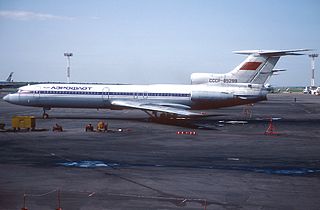
The Tupolev Tu-114 Rossiya is a retired large turboprop-powered long-range airliner designed by the Tupolev design bureau and built in the Soviet Union from May 1955. The aircraft was the largest and fastest passenger plane at that time and also had the longest range, at 10,900 km (6,800 mi). It has held the official title of fastest propeller-driven aircraft since 1960.

The Tupolev Tu-104 is a medium-range, narrow-body, twin turbojet-powered Soviet airliner. It was the second to enter regular service, behind the British de Havilland Comet and was the only jetliner operating in the world from 1956 to 1958, when the British jetliner was grounded due to safety concerns.

The Tupolev Tu-154 is a three-engined, medium-range, narrow-body airliner designed in the mid-1960s and manufactured by Tupolev. A workhorse of Soviet and (subsequently) Russian airlines for several decades, it carried half of all passengers flown by Aeroflot and its subsidiaries, remaining the standard domestic-route airliner of Russia and former Soviet states until the mid-2000s. It was exported to 17 non-Russian airlines and used as a head-of-state transport by the air forces of several countries.

Vnukovo, formally Vnukovo Andrei Tupolev International Airport, is a dual-runway international airport located in Vnukovo District, 28 km (17 mi) southwest of the centre of Moscow, Russia. It is one of the four major airports that serve Moscow, along with Domodedovo, Sheremetyevo, and Zhukovsky.
Kazakhstan Airlines was an airline from Kazakhstan, serving as national flag carrier of the country from its independence in 1991 until 1996. Following the disaster of the 1996 Charkhi Dadri mid-air collision, Kazakhstan Airlines ceased operations, and its role as flag carrier was transferred to Air Kazakhstan.

Aeroflot Flight 3352 was a regularly scheduled Aeroflot domestic flight in the Soviet Union from Krasnodar to Novosibirsk, with an intermediate landing in Omsk. While landing at Omsk Airport on Thursday, 11 October 1984, the aircraft crashed into maintenance vehicles on the runway, killing 174 people on board and four on the ground. While a chain of mistakes in airport operations contributed to the accident, its major cause was an air traffic controller falling asleep on duty.

Aeroflot Flight 4225 was a Tupolev Tu-154B-2 on a scheduled domestic passenger flight from Alma-Ata Airport to Simferopol Airport on 8 July 1980. The aircraft had reached an altitude of no more than 500 feet when the airspeed suddenly dropped because of thermal currents it encountered during the climb out. This caused the airplane to stall less than 5 kilometres from the airport, crash and catch fire, killing all 156 passengers and 10 crew on board. To date, it remains the deadliest aviation accident in Kazakhstan. At the time, the crash was the deadliest involving a Tupolev Tu-154 until Aeroflot Flight 3352 crashed in 1984, killing 178 people.

Aeroflot Flight 1691 crashed near Moscow Vnukovo Airport on 17 March 1979 killing 58 of the 119 people on board. The Tupolev Tu-104B operating the flight was overloaded and the crew received a false fire alarm.

Aeroflot Flight 964 was a flight operated by Aeroflot from Kutaisi Airport, Georgia to Domodedovo Airport, Moscow, Russian SFSR. On 13 October 1973, the Tupolev Tu-104 operating on the route crashed during its approach to Moscow, killing all 122 passengers and crew on board. It remains the deadliest accident involving a Tupolev Tu-104.

Aeroflot Flight 3519 was a scheduled flight, operated by a Tupolev Tu-154B-2 that crashed on December 23, 1984 due to an engine failure, 110 occupants were killed; one passenger had survived the accident.

Aeroflot Flight 3603 was a Tupolev Tu-154 operating a scheduled domestic passenger flight from Krasnoyarsk to Noril'sk, both in the Soviet Union, that crashed while attempting to land on 17 November 1981. Of the 167 passengers and crew on board, 99 were killed in the accident.

Aeroflot Flight 2415 was a regularly scheduled passenger flight from Moscow to Leningrad that crashed shortly after takeoff on 28 November 1976. The cause of the accident was attributed to crew disorientation as a result of artificial horizon failure in low visibility conditions.

Aeroflot Flight 3739 was a regularly scheduled Russian domestic flight from Irkutsk to Pulkovo Airport in Saint Petersburg that crashed during takeoff from Irkutsk International Airport on 9 February 1976. Twenty-four of the 114 people on board died in the accident.

Aeroflot Flight 1912 was a scheduled domestic Aeroflot passenger flight on the Odessa-Kiev (Kyiv)-Chelyabinsk-Novosibirsk-Irkutsk-Khabarovsk-Vladivostok route that crashed on 25 July 1971, making a hard landing at Irkutsk Airport. It touched down 150 metres (490 ft) short of the runway, breaking the left wing and catching fire. Of the 126 people on board the aircraft, 29 survived.

Aeroflot Flight 513 was a domestic scheduled passenger flight operated by Aeroflot that crashed during takeoff from Kuybyshev Airport in the Soviet Union on 8 March 1965, resulting in the deaths of 30 passengers and crew. It was the first fatal accident involving a Tupolev Tu-124.

Rus Flight 9633 was a cargo flight operated on an IL-76TD aircraft of Rus Airlines from Chkalovsky Airport (Moscow) to Taiyuan Wusu Airport (Taiyuan) with intermediate landings at Alykel Airport (Norilsk) and Bratsk Airport (Bratsk). On July 14, 2001, the plane carrying out this flight crashed a few seconds after takeoff from Chkalovsky Airport. All 10 people on board were killed.














